|
|
Some Side Trips around France
The Rugged Coastline of France
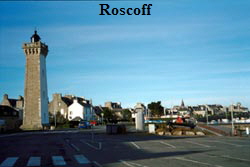 One of the more interesting tourist attractions in this part of France is the rugged coastline. After the air show practice on Tuesday, 2 December 1999, I checked my road map and headed north on highway D 69 to Roscoff. This is a prominent tourist center, but as it turned out, only in the summer. There were plenty of parking spaces all along the waterfront, and lots of the hotels, spas, restaurants and little tourist shops, which were all closed. The restaurants had their chairs stacked up on the tables, a sure sign they weren't open. But it was a great place to walk around, look at all the tourist stuff in the shop windows and enjoy not being shoved around by the crowds. One of the more interesting tourist attractions in this part of France is the rugged coastline. After the air show practice on Tuesday, 2 December 1999, I checked my road map and headed north on highway D 69 to Roscoff. This is a prominent tourist center, but as it turned out, only in the summer. There were plenty of parking spaces all along the waterfront, and lots of the hotels, spas, restaurants and little tourist shops, which were all closed. The restaurants had their chairs stacked up on the tables, a sure sign they weren't open. But it was a great place to walk around, look at all the tourist stuff in the shop windows and enjoy not being shoved around by the crowds.
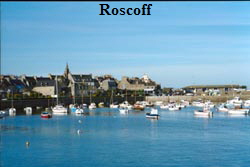 I spent a couple hours wandering around the waterfront, as well as a couple of the side streets. The little harbor was dotted with small boats tied up to buoys, not much sign of activity on this clear but brisk and windy afternoon. The harbor has a breakwater to protect it from the waves coming in from the open Atlantic, so I wandered out there. Even though I had on several layers of clothing, I didn't stay out there very long because of the cold. However that little bit was enough to convince me that the coast of Bretagne is indeed, worth seeing. I walked back to the car - the only one in the parking lot - and drove out to the headland that formed the other side of the harbor mouth. My trusty Michelin map said this was the Pointe de Blascon. I spent a couple hours wandering around the waterfront, as well as a couple of the side streets. The little harbor was dotted with small boats tied up to buoys, not much sign of activity on this clear but brisk and windy afternoon. The harbor has a breakwater to protect it from the waves coming in from the open Atlantic, so I wandered out there. Even though I had on several layers of clothing, I didn't stay out there very long because of the cold. However that little bit was enough to convince me that the coast of Bretagne is indeed, worth seeing. I walked back to the car - the only one in the parking lot - and drove out to the headland that formed the other side of the harbor mouth. My trusty Michelin map said this was the Pointe de Blascon. 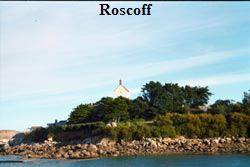 There was a small, old white stucco church out there on that promontory, the Chapel de Ste. Barbe. Again, mine was the only car in the parking lot, and I had to climb a couple hundred yards of rocky pathway to get there, only to find it, also, was closed for the season - with not so much as a sign to tell any of it's history. When I got back into town, I looked up the tourist information office - same story - "Ferme" (Closed). It was now getting on into the afternoon, so I headed back to St. Thegonnec. There was a small, old white stucco church out there on that promontory, the Chapel de Ste. Barbe. Again, mine was the only car in the parking lot, and I had to climb a couple hundred yards of rocky pathway to get there, only to find it, also, was closed for the season - with not so much as a sign to tell any of it's history. When I got back into town, I looked up the tourist information office - same story - "Ferme" (Closed). It was now getting on into the afternoon, so I headed back to St. Thegonnec.
A Walk Around St. Thegonnec
It was still clear and cool here, but not very much wind, so I decided to take a walk. I spotted a cemetery about half a mile from the auberge, so I walked up there and looked around. There were markers with dates back to the 1860's and 1870's, but most graves seemed to have new granite and marble markers. Along the back fence were stacked a lot of the old concrete markers, many of them broken and badly eroded, some almost illegible. It seems they had had a program of modernization. It was a very neat, well-manicured cemetery, curbed with graveled walks and trimmed lawns. There was one row of military-looking markers with 1939-45 dates, commemorating eight World War II casualties between the ages of 18 and 21, with seven crosses and one Star of David. From there I walked back to the Cathedral (Clos) of St. Thegonnec. 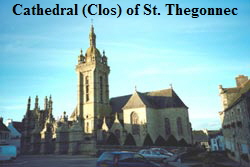 I heard from various people about a disastrous fire that had seriously damaged the main nave of the cathedral on the morning of 8 June 1998. So for the past 18 months the entire town had been working to restore the Clos to its original beauty. The most seriously damaged part of the building was the roof, which collapsed into the nave. The local townspeople and fire fighters had been able to save some of the l5th and 16th century artifacts and relics. The hand carved wood altar and other sacristy furniture and furnishings, including a huge pipe organ, were destroyed, however. The foyer was open, so I toured the picture gallery - fantastic photos of the day of the fire, and the efforts to fight it, and to salvage what they could of the furnishings. There was a plywood barrier built between the foyer and the main nave while the reconstruction was in progress, but I could look over the top, and see the damage to the roof, and the repairs that were under way. Must have been quite an experience for the local residents, but they seemed to have responded to the restoration effort. Organized under the slogan "Apres le feu la renaissance" (After the fire the renaissance). I did not find out how long it will take to finish the restoration. These projects usually go at the pace for which both money and volunteer labor are available. I heard from various people about a disastrous fire that had seriously damaged the main nave of the cathedral on the morning of 8 June 1998. So for the past 18 months the entire town had been working to restore the Clos to its original beauty. The most seriously damaged part of the building was the roof, which collapsed into the nave. The local townspeople and fire fighters had been able to save some of the l5th and 16th century artifacts and relics. The hand carved wood altar and other sacristy furniture and furnishings, including a huge pipe organ, were destroyed, however. The foyer was open, so I toured the picture gallery - fantastic photos of the day of the fire, and the efforts to fight it, and to salvage what they could of the furnishings. There was a plywood barrier built between the foyer and the main nave while the reconstruction was in progress, but I could look over the top, and see the damage to the roof, and the repairs that were under way. Must have been quite an experience for the local residents, but they seemed to have responded to the restoration effort. Organized under the slogan "Apres le feu la renaissance" (After the fire the renaissance). I did not find out how long it will take to finish the restoration. These projects usually go at the pace for which both money and volunteer labor are available.
An Aborted Trip to Pointe de St Mattieu
Wednesday morning turned out to be wet, with low clouds and off-and-on drizzle/rain. Several of us, the Millers, the Mollers and the Priests chatted over coffee before they headed out to the base to get checked in. I decided to try to get over to the westernmost point in France - the Pointe de St Mattieu - a little north and west of Brest. I stopped by the base to see if there was anything special to be seen there, but it just looked like they were going to sit around and tell each other lies about the "good old days", so I headed west on N.R.12 into Brest. It wasn't long before I decided this had been a mistake. It was after 12 noon, and I still had half of Brest to go through, specifically the harbor part of town, which is old and dirty, with lots of traffic lights, and snarled traffic. I wanted to be back to the auberge by 3:00 p.m. to meet the Engles, so after I'd gone about 5 km into town, I did a U-turn and headed back. Got to the auberge a little after 1:00 p.m., walked up the hill to the creperie and had lunch. When I returned to the auberge I found the place crawling with Americans. Among them were Larry Durbin, the person who had coordinated this whole show from the American end, and Charlie Snell, who had done a lot of "net surfing", collecting information on cheapest fares and tourist attractions. Another familiar name was "Hotdog" Brown who had done a lot of the e-mailing. I waited until about 4:15 p.m. for the Engles, and when they didn't arrive, I headed for the Greenwood Pub in Landivisiau.
A Trip to the Beaches
Several of the people at the auberge talked about visiting the beaches; the most serious of which were Dick Moller and his wife Cindi. I told them about the book I was reading, and showed them the detailed Michelin maps. When they decided to go, they asked if I wanted to join them. Bob Scobie also wanted to go. He and Dick were ex-Marine Corps Captains, had flown the F-8 at Beaufort, S.C., and then had gone on to Viet Nam for a tour before separating from the Corps. Bob went to work for Lockheed and Dick became a pilot for Northwest Airlines.
Dick and Cindi rented a small 4-door Renault, and he wanted to drive, if I'd do the navigating. The Mollers, Bob Scobie and I spent the evening making plans for the run up to Normandy on Saturday, 4 December 1999, and the return on Sunday.
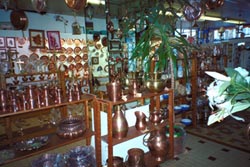 We left early Saturday morning taking a back road to N.R. l2 and headed east through Morlaix, Guingamp, St Brieuc, and Lamballe. We took N.176 to Dinan, Pontorson, where we got our first view of La Mont St. Michel and entered Normandy from Bretagne, then took N.R.175 north east across Normandy. At Villedieu we drove into town and found a couple shops that had literally tons of beautiful, heavy duty copper cookware. Cindi Moller ended up shipping home a large package of copper cookware that must have weighed 50 pounds! We left early Saturday morning taking a back road to N.R. l2 and headed east through Morlaix, Guingamp, St Brieuc, and Lamballe. We took N.176 to Dinan, Pontorson, where we got our first view of La Mont St. Michel and entered Normandy from Bretagne, then took N.R.175 north east across Normandy. At Villedieu we drove into town and found a couple shops that had literally tons of beautiful, heavy duty copper cookware. Cindi Moller ended up shipping home a large package of copper cookware that must have weighed 50 pounds!
We continued through St. Lo and north to N.R.13, headed east toward Omaha Beach where we spent the rest of the day. We decided to visit Utah Beach on Sunday. We turned off N.R.13 and drove into Grandcamp-Maisy. We drove through town, noted a couple of museums we might come back to, and moved on down the road a few miles and located Pointe du Hoc, which turned out to be one of the high points of the visit.
Pointe du Hoc is a promontory, about 100 feet high above the beaches. Omaha Beach stretches out for about five miles to the east, and across a small river mouth; Utah Beach lies to the northwest. The Pointe commands a view of both the beaches where the U.S. forces chose to land. The Germans had fortified The Pointe with concrete bunkers and pillboxes that could put down enfilading fire on the entire length of both beaches. The battle plan called for three companies of Rangers, under the command of Col. James Earl Rudder (a Texan who later became President of 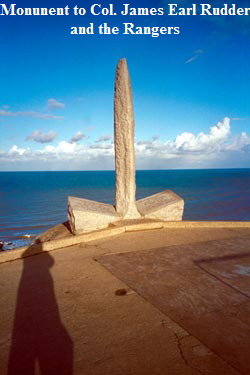 Texas A&M University), to scale the shear 100 foot cliffs and take The Pointe. Scaling those cliffs would be a real challenge on a calm, balmy Sunday afternoon, but to do it against a strongly fortified enemy force which was determined to keep you from doing it, seems impossible. Still, they did it, suffering 90% casualties. They had borrowed long ladders from the London Fire Department to scale the cliffs. They used long ropes with grappling hooks to rappel up the cliffs. The Germans rolled hand grenades down on top of them, but by late afternoon, the Rangers had fought their way to the top, and began clearing out the German defenders. It took them the better part of 48 hours to completely secure The Pointe. Texas A&M University), to scale the shear 100 foot cliffs and take The Pointe. Scaling those cliffs would be a real challenge on a calm, balmy Sunday afternoon, but to do it against a strongly fortified enemy force which was determined to keep you from doing it, seems impossible. Still, they did it, suffering 90% casualties. They had borrowed long ladders from the London Fire Department to scale the cliffs. They used long ropes with grappling hooks to rappel up the cliffs. The Germans rolled hand grenades down on top of them, but by late afternoon, the Rangers had fought their way to the top, and began clearing out the German defenders. It took them the better part of 48 hours to completely secure The Pointe.
The top of The Pointe had been bombed extensively by the U.S. Army Air Corps., and shelled by the U.S. Navy prior to the landing. Today yet, the surface, while covered in neatly manicured grass, still shows the craters made by this heavy bombardment. There are very few square feet of level ground on the top of Pointe du Hoc, even the area for the parking lot had to be leveled and paved.
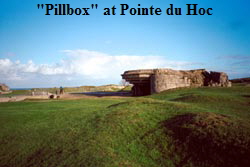 The concrete bunkers and pillboxes also show the effects of the pounding they took from the air and the sea, but seemed to have survived well enough to rain a hellish fire on the landing troops. On the interior walls of the largest of these fortifications there are several bronze plaques commemorating the heroic action that took place. One plaque, placed there by the Texas Historical Commission, specifically commemorates the work of Col. Rudder in leading his force in this action. The concrete bunkers and pillboxes also show the effects of the pounding they took from the air and the sea, but seemed to have survived well enough to rain a hellish fire on the landing troops. On the interior walls of the largest of these fortifications there are several bronze plaques commemorating the heroic action that took place. One plaque, placed there by the Texas Historical Commission, specifically commemorates the work of Col. Rudder in leading his force in this action.
The emotional impact of seeing what those Americans faced on that June morning in 1944, and the knowledge that they fought against those overwhelming obstacles and succeeded in, taking the high ground behind the beaches was overwhelming. 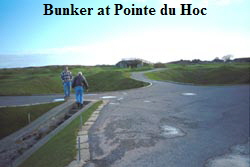 There are not enough words to express the feelings. I am convinced that there are ghost Battalions and Regiments standing guard over this bloody and sacred ground. Normandy has joined places in history along side Valley Forge, the Alamo, Gettysburg and Bataan. There are not enough words to express the feelings. I am convinced that there are ghost Battalions and Regiments standing guard over this bloody and sacred ground. Normandy has joined places in history along side Valley Forge, the Alamo, Gettysburg and Bataan.
From Pointe du Hoc, we continued to drive east along the Normandy beach. We stopped numerous times and walked out onto the beach to see several types of landing craft, still in the sand, rusting away. We didn't see any of the steel tank obstacles and concrete tank traps that lined the high water mark and extended well out into the surf. The time we were there was just shy of high tide, so we couldn't see those farther out, but it must have been an impressive collection of death traps for incoming landing craft, amphibian vehicles, and gear-loaded troops, fighting against the wave action and trying to get ashore alive. Bob Scobie brought along a number of plastic containers, and collected sand from the beach to take back to some of his ex-Marine buddies. Several hundred yards behind these beaches, the land rises sharply, and all along this stretch there are the remains of old German and/or French coastal defense fortifications, well battered by Allied air and naval bombardments, again many of the shell holes and bomb craters are still visible.
Our last stop of the afternoon was at the U.S. Military Cemetery at Colleville sur Mer, near the eastern end of Omaha Beach. This, like all the other overseas U.S. Military Cemeteries I've visited in the Philippines, southern France, and Luxembourg, is a place of beauty. There is a chapel, a memorial garden, a wall on which are inscribed the names of 1557 American soldiers who were killed and whose bodies were never recovered, either lost at sea on the way in, or blown to bits in the horrendous explosions that were so common in this type of combat. The cemetery itself contains almost 10,000 graves, each marked with a white marble Cross or Star of David, listing only the name, rank and the state which he called home. There are also about 25 women - mostly nurses who died during the invasion and early fighting to secure the beachhead.
The emotional aspect of the visit was profound. This section of French soil has been deeded to the United States. We wandered around for the better part of an hour. At sunset the buglers sounded "Taps" and lowered the two large United States flags. As we walked back to the car we noticed a placard by the entrance to the cemetery that read:
“THE AMERICAN CEMETERY AT COLLEVILLE SUR MER
At the top of this plateau overlooking Omaha Beach, gently sloping down to the sea whence came the liberators, this plot of French soil has been given in perpetuity to the United States.
Here lie nearly ten thousand soldiers. On a low wall around the monument are the names of the 1557 soldiers whose bodies were never found.
Visitor, look how many of them there were.
Look how young they were.
They died for your freedom.
Hold back your tears and keep silent.”
Nothing more can be, nor need be, said.
While in the cemetery, we met a group of Americans with a tour, and they told us about a nice hotel in Caen, so we looked at the map. Baycux looked like a good size city, and was much closer than Caen, so we decided to try there first. Bayeux is famous for their medieval tapestries, the best known being the multi-paneled one depicting the Battle of Hastings in 1066 when the Norman king, William the Conqueror, defeated the English Kind Harold. It was nearly dark when we got there, and after driving up and down the main drag, we decided to try the Hotel Le Lion d'Or (The Golden Lion). There were three rooms left, so we took them, took our stuff up, and walked down the street to a restaurant we had spotted during our short tour. By the time we finished dinner, we were all ready to turn in, so we window shopped our way back to the hotel and called it a day.
Sunday morning, we decided not to partake of a continental breakfast at the hotel, checked out and headed out of town. Near the edge of town, we spotted a McDonald's, and we decided to get egg McMuffins. While eating, we read through some brochures we'd picked up at the hotel, and decided to stop by the Memorial Museum of the Battle of Normandy in Bayeux. It didn't open until 10:00 a.m., so we walked around the grounds inspecting the tanks, armored personnel carriers, heavy artillery pieces, etc., that were mounted on the grounds. We spent almost three hours wandering through the exhibits, dioramas, displays of uniforms and equipment, and watched a 30-minute movie of the invasion. We could have spent the rest of the day there, but after a short conference, we decided to press on, to bypass Utah Beach, on the way back to St. Thegonnec.
|